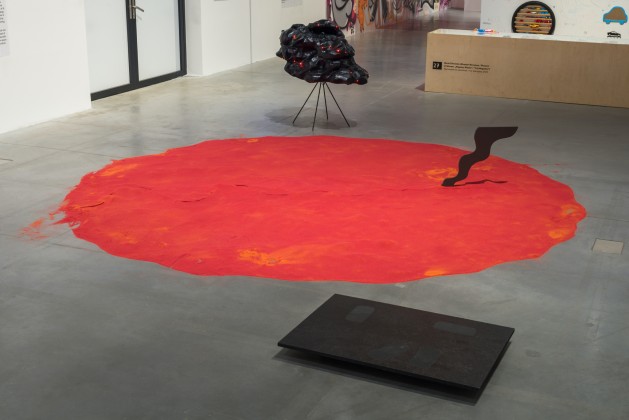The artist refers to the romantic concept of a journey into the unknown. He confronts the phantasms associated with the car, such as freedom, comfort and the possibility of travelling all the way to the horizon, with apocalyptic visions of the future associated with climate change and the oppressive urban present. 'The Burning Sun' depicts an absurd scene: a sun on whose surface a fire has broken out. Up close, one can see the gently undulating topography and the geometric modelling made in the sand, reminiscent of an architectural model - a tangle of buildings, roads, squares and bridges. It is a red-hot dried-up city, with clouds of smoke rising from its hottest point. The work addresses the problem of overheating in cities and the presence of heat islands in them. A very important, even symbolic element of the work is the material used, i.e. sand - the third most exploited natural resource (after water and air) and the main building material of contemporary cities. A material without which there would be no modern industrialisation, and whose overexploitation causes huge changes to the environment. The association with a building site or children's play in a sandpit is also valid.
The "Swarm" is a shapeless form resembling a cloud in 'black metallic' - as if created by a gigantic car crash, in which all the vehicles merge into a seamless mass under the impact of the collision. The object is abstract and its automotive origin is revealed by the orange LEDs placed here and there, which flash to the rhythm of the hazard lights. The hazard lights symbolise a malfunction, congestion, traffic jam, lack of mobility or illegal occupation of space.
The work set up near the "Burning Sun" looks like a storm cloud coming over the city and refers to the mass of cars that drive from the suburbs into city centres every day. "Urban Legend" is a mockup that depicts a car park entirely covered in asphalt - it is an imitation made from a material used in modelling. The asphalt is wet from rain, with dry patches in some places. We can guess that these are spots where cars were parked a while ago. Perhaps they just drove away, or perhaps they evaporated....
Kornel Janczy
Kornel Janczy works in painting and creates objects. His installations usually consist of many small objects that resemble parascientific models. Their constructions are like a landscape or a route through an undulating terrain. The artist is interested in the perceived paradoxical proximity of investment projects of different scales and origins in the Polish landscape. He portrays random plots of land, newly opened construction sites, lonely electric traction poles or roads that come to an end in the middle of nowhere. He is a graduate of the Faculty of Painting at the Academy of Fine Arts in Krakow (2010) and a doctoral student at the Pedagogical University in Krakow (2016). He studied at the Akademie der Bildende Künste in Munich. Since 2016 he has been an assistant at the Faculty of Art of the Pedagogical University of Krakow. He was a scholarship holder of the Minister of Culture (2018) and the Adam Mickiewicz Institute. He has been exhibiting in Poland and abroad since 2013. His works are also in the collection of the Bunkier Sztuki Contemporary Art Gallery in Krakow.
Rok powstania: 2022
sand, wood, acrylic paint
Courtesy of the Artist

